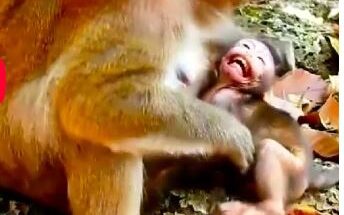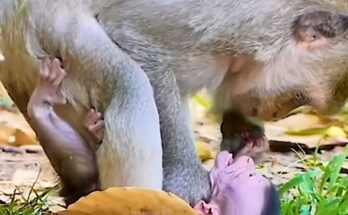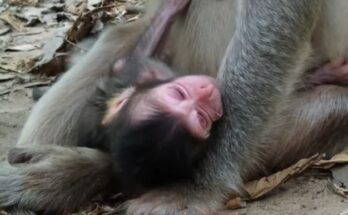Deep within the heart of the jungle, a quiet but devastating crisis has unfolded—a newborn monkey lies weak and lethargic, its life hanging in the balance. The cause? Its mother has gone dry, unable to produce the milk that is essential for her infant’s survival. This milk crisis may seem like a rare or isolated incident, but in reality, it reflects a broader, more troubling pattern emerging in wild ecosystems stressed by climate change, deforestation, and dwindling food supplies.
The mother, a young female from a troop of capuchin monkeys, was seen initially nursing her baby successfully. But over a period of just a few days, she became increasingly agitated and visibly thinner. Observers noted that her body condition was deteriorating—her ribcage prominent, her energy low—and her infant was no longer suckling with the same enthusiasm. Eventually, she stopped producing milk altogether. For the newborn, this was a potentially fatal turning point.
Milk is a newborn monkey’s sole source of hydration, nutrition, and immune support in the early weeks of life. Unlike older animals, infants cannot digest solid food or fend for themselves. Deprived of milk, they weaken quickly, becoming vulnerable to infections, dehydration, and even predation. The newborn in this case began to show signs of dehydration: sunken eyes, shallow breathing, and limited movement. Without intervention or an adoptive nursing female, survival odds are slim.
So, what causes a monkey mother to stop lactating? In the wild, lactation depends on both hormonal balance and adequate nutrition. If a mother is not eating enough high-energy food—fruits, seeds, insects—her body prioritizes its own survival over milk production. Recent environmental changes in this particular jungle, including an unusually long dry season and human encroachment that reduced access to fruiting trees, have made foraging more difficult. As the food supply dwindles, the mother’s milk dries up.
This situation is not unique. Field researchers and conservationists report similar incidents with increasing frequency. In regions where forests are fragmented or food chains disrupted, female primates and other mammals often struggle to meet the demands of motherhood. Infant mortality rates among monkeys in these areas are climbing, a trend that signals deeper ecological imbalance.
What’s particularly heartbreaking is the emotional toll such a crisis takes on primate mothers. Monkeys are intelligent and social animals with strong maternal instincts. A mother unable to feed her baby often appears distressed, clinging to her infant even after it has died, a haunting display of grief that reflects a capacity for emotional depth often underestimated in wild animals.
There are no easy solutions to this crisis. Rehabilitating a starving mother monkey in the wild is nearly impossible without disrupting troop dynamics or humanizing the animal. However, the broader solution lies in restoring and protecting natural habitats. Ensuring that monkey populations have access to diverse, abundant food sources will support the health of both mothers and infants.
As conservationists watch over the fading infant, its struggle serves as a grim reminder: when nature suffers, the most vulnerable suffer first. The milk crisis in the jungle is more than a single tragedy—it’s a warning of what’s to come if we continue to ignore the ecological balance that all species, including our own, depend on.


